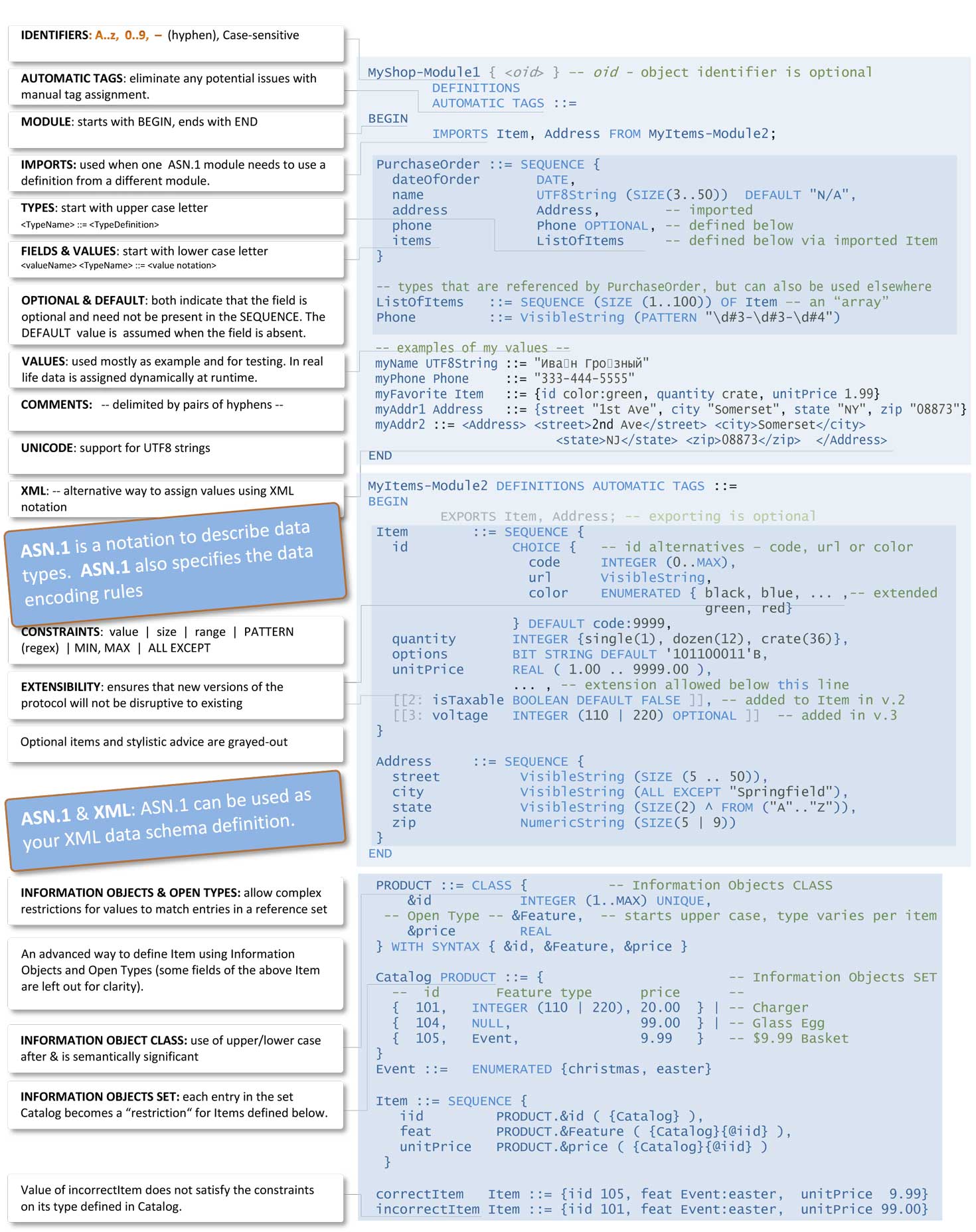Resources

Obsolete, not commonly used or deprecated syntax is greyed out below
Object Identifier Values
oid2 OBJECT IDENTIFIER ::= {joint-iso-itu-t ds(5)}
oid3 OBJECT IDENTIFIER ::= { oid2 modules(0) }
oid4 OBJECT IDENTIFIER ::= { oid3 basic-types(1) }
oid5 OBJECT IDENTIFIER ::= { 2 5 0 1 } -- equals oid4
| Object identifier value | Meaning |
| ISO member bodies | |
| US (ANSI) | |
| RSA Data Security, Inc. | |
| RSA Data Security, Inc. PKCS | |
| directory services (X.500) | |
| directory services-algorithms |
TYPES
|
Basic Types
|
Tag [01/01] [02/02] [03/03] [04/04] [06/06] [09/09] [10/0A] [16/10] [16/10] ---- [12/0C] [18/12] [22/16] [26/1A] [31/ *] [32/ *] [33/ *] [34/ *] |
Other Types
|
Tag [08/08] [11/0B] [35/ *] [36/ *] [17/11] [17/11] [23/17] [24/18] [19/13] [20/14] [21/15] [25/19] [27/1B] [28/1C] [29/1D] [30/1E] [26/1A] [20/14] |
Information Objects
Use of upper/lower case after ‘&’ is semantically significant.
&id OBJECT IDENTIFIER UNIQUE,
&simple-value ENUMERATED {high, low} DEFAULT low,
&Set-of-values INTEGER OPTIONAL,
&Any-type,
&an-inform-object SOME-CLASS,
&A-set-of-objects SOME-OTHER-CLASS
} WITH SYNTAX
{ KEY &id
[ URGENCY &simple-value ] -- Optional
[ VALUE-RANGE &Set-of-values ]
PARAMETERS &Any-type
SYNTAX &an-inform-object
MATCHING-RULES &A-set-of-objects
}
my-object MY-CLASS ::= {
KEY { ....... }
URGENCY high
VALUE-RANGE { 1..10 | 20..30 }
PARAMETERS My-type
SYNTAX defined-syntax
MATCHING-RULES { at-start | at-end | exact }
}
My-object-set MY-CLASS ::= {
object1 | object2 | object3,
...,
version2-object
}
Message ::= SEQUENCE {
-- Has to be an OBJECT IDENTIFIER (KEY) from the set:
key MY-CLASS.&id ({My-object-set}),
-- Has to be the PARAMETERS for the object with KEY:
parms MY-CLASS.&Any-type ( {My-object-set} {@key} )
}
Variable type value fields and value set fields are out of the scope of this reference card
VALUES
Values are usually specified in ASN.1 modules only for indicating defaults, or ranges for constraining items (such as the maximum length of a name).
maxAge INTEGER ::= 120
bitmask BIT STRING ::= ‘7FFF’H
defaultBytes OCTET STRING ::= ‘010F’H
placeholder NULL ::= NULL
defaultID OBJECT IDENTIFIER ::= {joint-iso-itu-t country(16) us(840)}
defaultPrice REAL ::= 9.99
Item ::= SEQUENCE {
id CHOICE { -- id alternatives - code, url or color
code INTEGER (0..MAX),
url VisibleString,
color ENUMERATED { black, blue, ... ,-- extended
green, red}
} DEFAULT code:9999,
quantity INTEGER {single(1), dozen(12), crate(36)},
options BIT STRING DEFAULT '101100011'B,
unitPrice REAL ( 1.00 .. 9999.00 ),
... , -- extension allowed below this line
[[ isTaxable BOOLEAN DEFAULT FALSE ]], -- added to Item in v.2
[[ voltage INTEGER (110 | 220) OPTIONAL ]] -- added in v.3
}
defaultItem Item ::= { -- This is a value for the type above
id code : 1,
quantity single,
options '0'B,
unitPrice 1.99
}
ListOfNumbers ::= SEQUENCE OF INTEGER
firstPrimeNumbers ListOfNumbers ::= {1, 2, 3, 5, 7, 11, 13, 17}
name1 UTF8String ::= “Joe” -- can also hold international characters
phone NumericString ::= “8885551212”
text IA5String ::= “Arbitrary text - with punctuation, no problem.”
name2 VisibleString ::= “Joe” -- US ASCII without control characters
myDay DATE ::= “2012-01-31”
noon TIME-OF-DAY ::= “12:00:00”
noonMyDay DATE-TIME ::= “2012-01-31T12:00:00”
lunchtime DURATION ::= “PT1H” -- one hour for lunch
Here is a common use for value notation for limiting a string size, especially if the same value will be used in multiple places:
VisibleString (SIZE (0..upperSize) )
ItemList ::= SEQUENCE (SIZE(0..upperSize)) OF Item
PARAMETERIZATION
All assignments defining reference names (type, value, class definitions, object definitions, object set) can be given a dummy parameter list. Here we have two dummy parameters - normal-priority and Parameter.
SEQUENCE {
component1 INTEGER DEFAULT normal-priority,
component2 Parameter }
Now we define our messages as a choice of two possibilities that differ only in the default priority and the Type that is to be used:
first Invoke-message { low-priority, Type1 },
second Invoke-message { high-priority, Type2 },
... }
Messages ::= CHOICE { -- This is what the above expands to
first SEQUENCE {
component1 INTEGER DEFAULT low-priority,
component2 Type1 },
second SEQUENCE {
component1 INTEGER DEFAULT high-priority,
component2 Type2 },
... }
ENCODINGS
Bit-wide |
PER: A compact binary encoding transferring the minimum information needed to identify a value. |
Byte-wide |
OER: A byte-aligned encoding designed for fast encoding/decoding |
BER: A type-length-value (TLV) style of encoding |
|
DER: An encoding with only one way to encode a given value, used in security work. |
|
CER: Another security-related encoding, rarely used. |
|
XML |
XER: Encoding ASN.1 values as XML syntax. |
ECN |
An encoding control notation (ECN) is available to completely determine the encoding of ASN.1 values. |